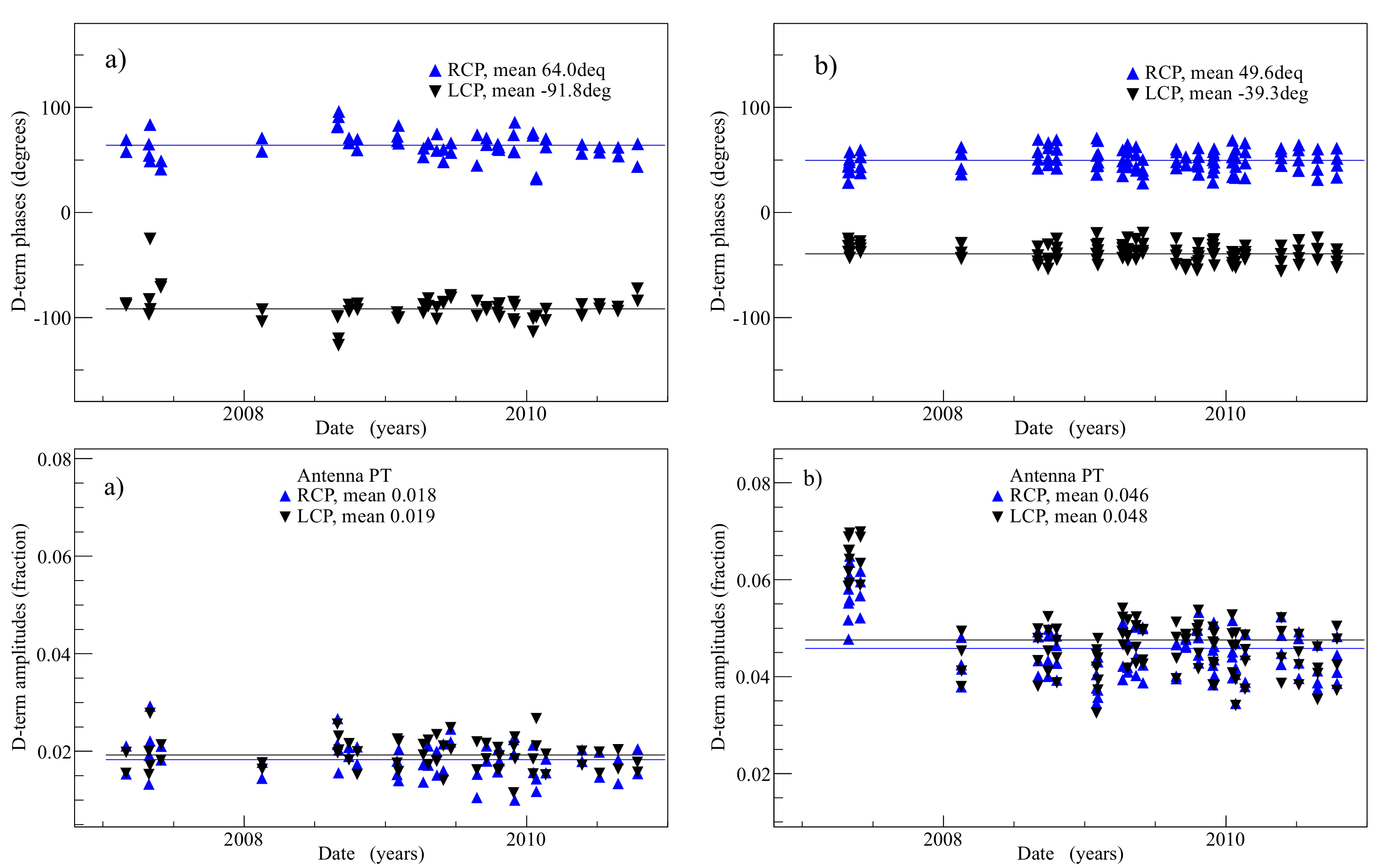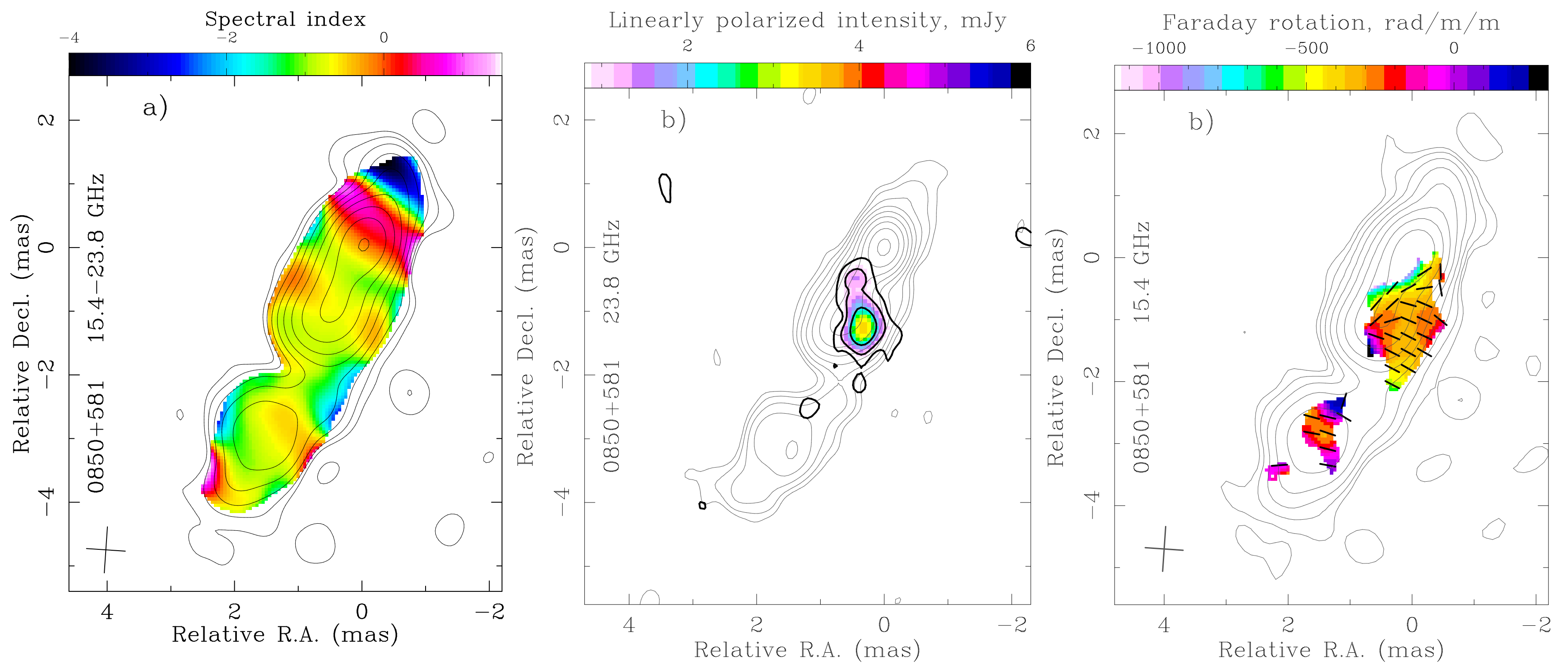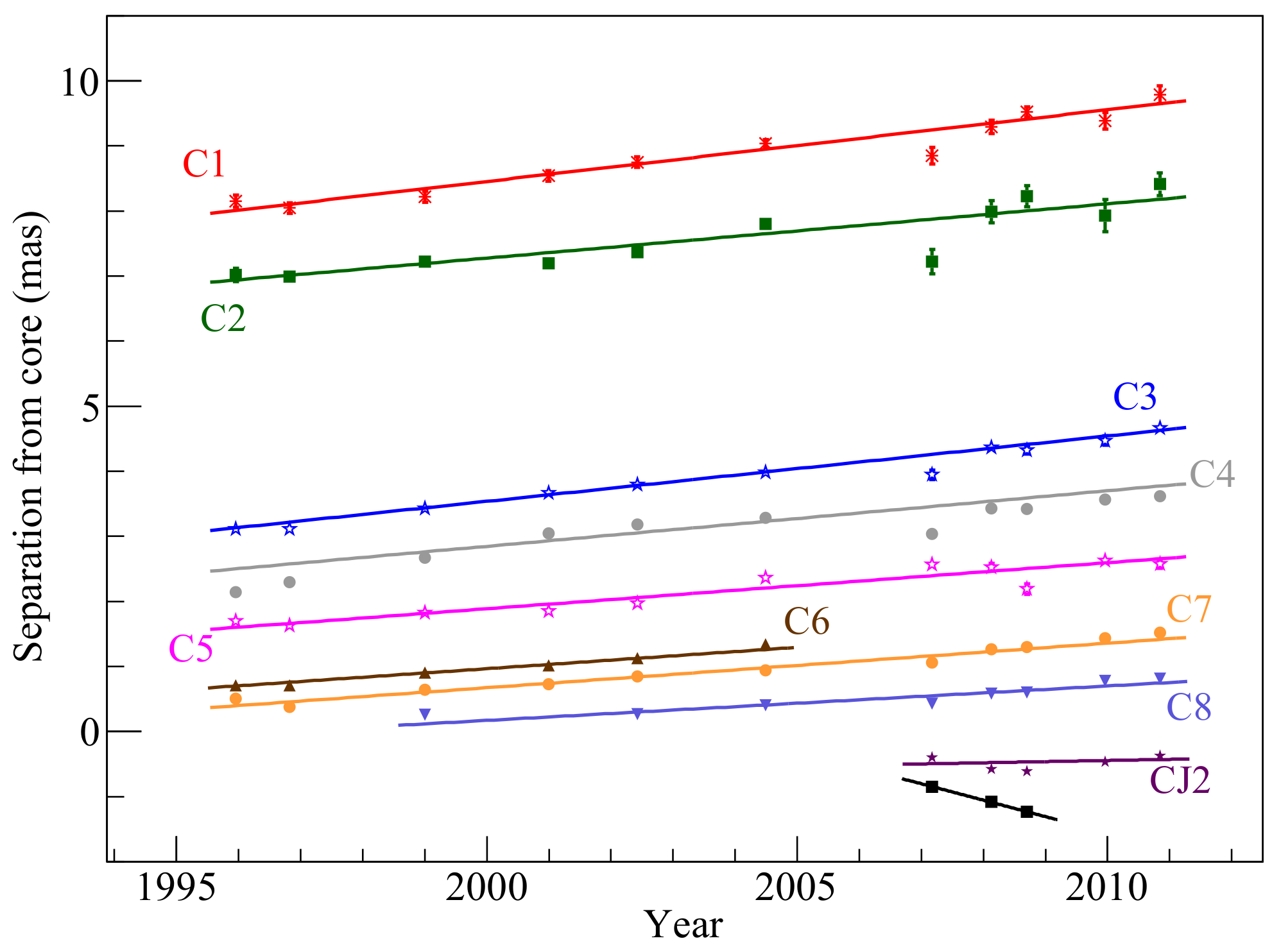Multi-Frequency VLBA Polarimetry and the Twin-Jet Quasar 0850+581 †
Abstract
:1. Introduction
2. Temporal Behavior of D-Term Amplitudes and Phases
3. Quasar 0850+581
3.1. Jet Parameters and Kinematics
3.2. Linear Polarization
3.3. Faraday Rotation Measure
4. Discussion
Acknowledgments
Author Contributions
Conflicts of Interest
References
- Meier, D.L.; Koide, S.; Uchida, Y. Magnetohydrodynamic Production of Relativistic Jets. Science 2001, 291, 84–92. [Google Scholar] [CrossRef] [PubMed]
- Roberts, D.H.; Wardle, J.F.C.; Brown, L.F. Linear polarization radio imaging at milliarcsecond resolution. Astrophys. J. 1994, 427, 718–744. [Google Scholar] [CrossRef]
- Leppanen, K.J.; Zensus, J.A.; Diamond, P.J. Linear Polarization Imaging with Very Long Baseline Interferometry at High Frequencies. Astron. J. 1995, 110, 2479. [Google Scholar] [CrossRef]
- Gómez, J.L.; Marscher, A.P.; Alberdi, A.; Jorstad, S.G.; Agudo, I. Polarization Calibration of the VLBA Using the D-terms. VLBA Sci. Memo 2002, 30, 16. [Google Scholar]
- Kovalev, Y.Y.; Lobanov, A.P.; Pushkarev, A.B.; Zensus, J.A. Opacity in compact extragalactic radio sources and its effect on astrophysical and astrometric studies. Astron. Astrophys. 2008, 483, 759–768. [Google Scholar] [CrossRef]
- Bridle, A.H.; Greisen, E.W. The NRAO AIPS Project—A Summary. Available online: https://library.nrao.edu/public/memos/aips/memos/AIPSM_087.pdf (accessed on 7 November 2017).
- Taylor, G.B.; Myers, S.T. Polarization Angle Calibration Using the VLA Monitoring Program. Available online: http://citeseerx.ist.psu.edu/viewdoc/summary?doi=10.1.1.23.6609 (accessed on 7 November 2017).
- Lister, M.L.; Aller, H.D.; Aller, M.F.; Cohen, M.H.; Homan, D.C.; Kadler, M.; Kellermann, K.I.; Kovalev, Y.Y.; Ros, E.; Savolainen, T.; et al. MOJAVE: Monitoring of Jets in Active Galactic Nuclei with VLBA Experiments. V. Multi-Epoch VLBA Images. Astron. J. 2009, 137, 3718–3729. [Google Scholar] [CrossRef]
- Kravchenko, E.V.; Kovalev, Y.Y.; Sokolovsky, K.V. Parsec-scale Faraday rotation and polarization of 20 active galactic nuclei jets. Mon. Not. Roy. Astron. Soc. 2017, 467, 83–101. [Google Scholar] [CrossRef]
- Lisakov, M.M.; Kovalev, Y.Y.; Savolainen, T.; Hovatta, T.; Kutkin, A.M. A connection between γ-ray and parsec-scale radio flares in the blazar 3C 273. Mon. Not. Roy. Astron. Soc. 2017, 468, 4478–4493. [Google Scholar] [CrossRef]
- Kravchenko, E.V.; Kovalev, Y.Y.; Hovatta, T.; Ramakrishnan, V. Multiwavelength observations of the γ-ray flaring quasar S4 1030+61 in 2009-2014. Mon. Not. Roy. Astron. Soc. 2016, 462, 2747–2761. [Google Scholar] [CrossRef]
- Lister, M.L.; Homan, D.C. MOJAVE: Monitoring of Jets in Active Galactic Nuclei with VLBA Experiments. I. First-Epoch 15 GHz Linear Polarization Images. Astron. J. 2005, 130, 1389–1417. [Google Scholar] [CrossRef]
- Hovatta, T.; Lister, M.L.; Aller, M.F.; Aller, H.D.; Homan, D.C.; Kovalev, Y.Y.; Pushkarev, A.B.; Savolainen, T. MOJAVE: Monitoring of Jets in Active Galactic Nuclei with VLBA Experiments. VIII. Faraday Rotation in Parsec-scale AGN Jets. Astron. J. 2012, 144, 105. [Google Scholar] [CrossRef]
- Lister, M.L.; Aller, M.F.; Aller, H.D.; Homan, D.C.; Kellermann, K.I.; Kovalev, Y.Y.; Pushkarev, A.B.; Richards, J.L.; Ros, E.; Savolainen, T. MOJAVE: XIII. Parsec-scale AGN Jet Kinematics Analysis Based on 19 years of VLBA Observations at 15 GHz. Astron. J. 2016, 152, 12. [Google Scholar] [CrossRef]
- Osterbrock, D.E. Astrophysics of Gaseous Nebulae and Active Galactic Nuclei; University Science Books: Mill Valley, CA, USA, 1989. [Google Scholar]
- Wright, E.L. A Cosmology Calculator for the World Wide Web. Publ. Astron. Soc. Pac. 2006, 118, 1711–1715. [Google Scholar] [CrossRef]
| 1. | |
| 2. | |
| 3. |



| Project Code | Date | Calibrator | Reference |
|---|---|---|---|
| BK134 | 1 March 2007, 30 April 2007, 3 May 2007, 1 April 2007 | 4C +39.25 | E.K. [9] |
| BK142 | 17 February 2008 | 0833+585 | E.K. (This paper, |
| 4C +39.25 | E.K. et al. in prep.) | ||
| BK150 | 2 September 2008, 5 September 2008, 2 October 2008, 23 October 2008 | 3C454.3 | E.K. |
| 2 February 2009, 5 February 2009, 9 April 2009, 22 April 2009, | OJ287 | ||
| 14 May 2009 | |||
| 1 June 2009, 20 June 2009 | 3C454.3 | ||
| SE2087A | 28 August 2009, 25 October 2009, 5 December 2009, 26 January 2010 | OP 313 | M.Lisakov [10], |
| Lisakov et al. in prep. | |||
| SE2087B | 22 September 2009, 22 October 2009, 3 December 2009, 18 January 2010, | 3C454.3 | T. Savolainen |
| 21 February 2010 | |||
| SE2087E | 24 May 2010, 9 July 2010, 28 August 2010, 18 October 2010 | OJ 287 | E.K. [11] |
© 2017 by the authors. Licensee MDPI, Basel, Switzerland. This article is an open access article distributed under the terms and conditions of the Creative Commons Attribution (CC BY) license (http://creativecommons.org/licenses/by/4.0/).
Share and Cite
Kravchenko, E.; Kovalev, Y.Y. Multi-Frequency VLBA Polarimetry and the Twin-Jet Quasar 0850+581. Galaxies 2017, 5, 92. https://doi.org/10.3390/galaxies5040092
Kravchenko E, Kovalev YY. Multi-Frequency VLBA Polarimetry and the Twin-Jet Quasar 0850+581. Galaxies. 2017; 5(4):92. https://doi.org/10.3390/galaxies5040092
Chicago/Turabian StyleKravchenko, Evgeniya, and Yuri Y. Kovalev. 2017. "Multi-Frequency VLBA Polarimetry and the Twin-Jet Quasar 0850+581" Galaxies 5, no. 4: 92. https://doi.org/10.3390/galaxies5040092





